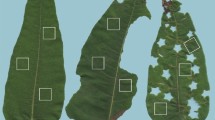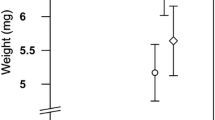Abstract
We tested the effects of defoliation-induced changes in silver birch, Betula pendula, foliar chemistry (delayed induced resistance, DIR) on the fitness and immune defense of the gypsy moth, Lymantria dispar. We measured larval developmental time, pupal weight, rate of survival to the adult stage, and five characteristics of larval immune defense: (1) encapsulation response; (2) phenoloxidase activity; (3) hemocyte concentration and (4) lysozyme-like activity in the hemolymph; and (5) resistance to infection by L. dispar nucleopolyhedrovirus (LdMNPV). The latter is an entomopathogenic baculovirus that often causes epizootics during outbreaks of L. dispar. We also measured the involvement of foliage non-tannin phenolic compounds in resistance of B. pendula to herbivory as well as the relationship between the compounds we identified and L. dispar development, growth, and survival. Leaves of B. pendula with previous defoliation history contained increased levels of myricetin glycoside, two flavonoid aglycones (acacetin and tetrahydroxy-flavone dimethyl ether), as well as one unidentified simple phenolic. The concentrations of two glycosides of quercetin, as well as the content of one unidentified flavonoid glycoside were significantly decreased under defoliation treatment. DIR of B. pendula retarded larval growth rate and increased lysozyme-like activity in the hemolymph, but did not affect encapsulation response, phenoloxidase activity, or hemocyte count. We did not find any DIR-mediated tritrophic interactions among birch, gypsy moth, and LdMNPV. After viral inoculation, the mean hemocyte counts in larvae reared on an individual tree correlated significantly with the survival of larvae reared on that same tree, indicating that hemocyte density in hemolymph might be associated with resistance to viral infection. We found a strong positive correlation between the concentration of 1-(4″-hydroxyphenyl)-3′-oxopropyl-β-D-glucopyranose and L. dispar survival rate, which may indicate an unlikely role of this dominant non-tannin phenolic in B. pendula defense against L. dispar. Our study also shows that several immune characteristics of insects that function as barriers against different groups of parasites are differently affected by plant induced defenses. This underscores the importance of considering multiple factors when characterizing barriers to insect immunity.




Similar content being viewed by others
References
Bakhvalov, S. A., Martemyanov, V. V., Kukushkina, T. A., and Vysochina, G. I. 2009. The dynamics of phenolic compounds and soluble sugars in the leaves of the silver birch (Betula pendula Roth) after defoliation and their significance in entomological plant resistance. Biology Bull. 36:449–454.
Barbehenn, R. V., Jaros, A., Lee, G., Mozola, C., Weir, Q., and Salminen, J. -P. 2009 Hydrolyzable tannins as “quantitative defenses”: Limited impact against Lymantria dispar caterpillars on hybrid poplar. J. Insect Physiol. 55:297–304.
Bradford, J. M. 1976. A rapid and sensitive method for the quantification of microgram quantities of protein utilizing the principle of protein-dye binding. Anal. Biochem. 72:248–254.
Bruinsma, M. and Dicke, M. 2008. Herbivore-induced indirect defense: from induction mechanisms to community ecology, pp. 31–60, in A. Schaller (ed.). Induced Plant Resistance to Herbivory. Springer Verlag, Berlin, Germany.
Cook, S. P., Webb, R. E., Podgwaite, J. D., and Reardon, R. C. 2003. Increased mortality of gypsy moth Lymantria dispar (L.) (Lepidoptera: Lymantriidae) exposed to gypsy moth nuclear polyhedrosis virus in combination with the phenolic glycoside salicin. J. Econ. Entomol. 96:1662–1667.
Cory, J. S. and Hoover, K. 2006. Plant-mediated effects in insect-pathogen interactions. Trends in Ecol. Evol. 21:278–286.
D’amico, V., Elkinton, J. S., Dwyer, G., Willis, R. B., and Montgomery, M. E. 1998. Foliage damage does not affect within-season transmission of an insect virus. Ecology 79:1104–1110.
Felton, G. W. and Duffey, S. S. 1990. Inactivation of a baculovirus by quinones formed in insect-damaged plant tissue. J. Chem. Ecol. 16:1211–1236.
Freitak, D., Ots, I., Vanatoa, A., and Horak, P. 2003 Immune response is energetically costly in white cabbage butterfly pupae. Proc. R. Soc. London. Ser. B 270:S220–S222.
Hajek, A. E. and Tobin, P. C. 2009. North American eradications of Asian and European gypsy moth, pp. 71–89, in A. E. Hajek, T. Glare, and M. O’Callaghan (eds.). Use of Microbes for Control and Eradication of Invasive Arthropods. Springer Science & Business Media B.V., Dordrecht, The Netherlands.
Haukioja, E. 2005. Tree defenses against insects, pp. 279–296, in E. Bent and S. Tuzun (eds.). Multigenic and Induced Systemic Resistance in Plants. Springer Science + Business Media, New York, USA.
Haviola, S., Kapari, L., Ossipov, V., Rantala, M. J., Ruuhola, T., and Haukioja, E. 2007. Foliar phenolics are differently associated with Epirrita autumnata growth and immunocompetence. J. Chem. Ecol. 33:1013–1023.
Hetru, C., Hoffmann, D., and Bulet, P. 1998. Antimicrobial peptides from insects, pp. 40–66, in P. T. Brey and D. Hultmark (eds.). Molecular Mechanisms of Immune Responses in Insects. Chapman & Hall, New York.
Hoffmann, J. A., Kafatos, F. C., Janeway, C. A., Jr., and Ezekowitz, R. A. B. 1999. Phylogenetic perspectives in innate immunity. Science 284:1313–1318.
Hoover, K., Kishida, K. T., Digiorgio, L. A., Workman, J., Alaniz, S. A., Hammock, B. D., and Duffey, S. S. 1998. Inhibition of baculoviral disease by plant-mediatedperoxidase activity and free radical generation. J. Chem. Ecol. 24:1949–2001.
Howe, G. A. and Schaller, A. 2008. Direct defenses in plants and their induction by wounding and insect herbivores, pp. 7–29, in A. Schaller (ed.). Induced Plant Resistance to Herbivory. Springer, New York, USA.
Hunter, M. D. and Schultz, J. C. 1993. Induced plant defenses breached? Phytochemical induction protects an herbivore from disease. Oecologia 94:195–203.
Il’inykh, A. V. 2007. Epizootiology of baculoviruses. Biol. Bull. 34:434–441.
Iwanaga, S. and Lee, B. L. 2005. Recent advances in the innate immunity of invertebrate animals. J. Biochem. Mol. Biol. 38:128–150.
Kapari, L, Haukioja, E., Rantala, M. J., and Ruuhola, T. 2006. Immune defence of a defoliating insect interacts with induced plant defence during a population outbreak. Ecology 87:291–296.
Keinänen, M. and Julkunen-Tiitto, R. 1998. High-performance liquid chromatographic determination of flavonoids in Betula pendula and Betula pubescens leaves. J. Chromatogr. A 793:370–377.
Keinänen, M., Julkunen-Tiitto, R., Mutikainen, P., Walls, M., Ovaska, J., and Vapaavuori, E. 1999. Trade-offs in phenolic metabolism of silver birch: effects of fertilization, defoliation, and genotype. Ecology 80:1970–1986.
Khodyrev, V. P., Teshebaeva, Z. A., Toktoraliev, B. A., and Bakhvalov, S. A. 2010. Entomopathogenic microorganisms in the foci of the gypsy moth (Lymantria dispar L.) in nut-fruit forests of the South of Kyrgyzstan. Contemporary Problems of Ecology 3:509–514.
Koltunov, E. V., Ponomarev, V. I., and Fedorenko, S. I. 1998. The Ecology of Gypsy moth under Anthropogenic Conditions. UrB RAS, Yekaterinburg, 217 pp.
Lahtinen, M., Salminen, J-P., Kapari, L., Lempa, K., Ossipov, V., Sinkkonen, J., Valkama, E., Haukioja, E., and Pihlaja, K. 2004. Defensive effect of surface flavonoid aglycones of Betula pubescens leaves against first instar Epirrita autumnata larvae. J. Chem. Ecol. 30:2257–2268.
Lahtinen, M. Lempa, K., Salminen, J-P., and Pihlaja, K. 2006. HPLC analysis of leaf surface flavonoids for preliminary classification of birch species. Phytochem. Anal. 17:197–203.
Larsson, S. 2002. Resistance in trees to insects—an overview of mechanisms and interactions, pp. 1–29, in M. R. Wagner, K. M. Clancy, F. Lieutier, and T. D. Paine (eds.). Mechanisms and Deployment of Resistance in Trees to Insects. Kluwer Academic Publishers, Dordrecht, The Netherlands.
Lazarević, J., Perić-Mataruga, V., Stojković, B., and Tucić, N. 2002. Adaptation of the gypsy moth to an unsuitable host plant. Entomol. Exp. Appl. 102:75–86.
Lee, K. P., Cory, J. S., Wilson, K., Raubenheimer, D., and Simpson, S. J. 2006. Flexible diet choice offsets protein costs of pathogen resistance in a caterpillar. Proc. R. Soc. London. Ser. B 273:823–829.
Leonard, D. E. 1981. Bioecology of gypsy moth, pp. 9–29, in C. C. Doane and M. L. McManus (eds.). The Gypsy Moth: Research Toward Integrated Pest Management. US Department of Agriculture, Washington, D.C.
Lindroth, R. L., Hwang, S., and Osier, T. L. 1999. Phytochemical variation in quaking aspen: Effects on gypsy moth susceptibility to nuclear polyhedrosis virus. J. Chem. Ecol. 25:1331–1341.
Martemyanov, V. V., Bakhvalov, S. A., Dubovskiy, I. M., Glupov, V. V., Salakhutdinov, N. F., and Tolstikov, G. A. 2006. Effect of tannic acid on the development and resistance of the gypsy moth Lymantria dispar L. to viral infection. Doklady Biochem. Biophys. 409:219–222.
Martemyanov, V. V., Bakhvalov, S. A., Rantala, M. J., Dubovskiy, I. M., Shultz, E. E., Strelnikov, A. G., and Glupov. V. V. 2009. The response of gypsy moth Lymantria dispar L. infected with nucleopolyhedrovirus on induced resistance of birch Betula pendula Roth. Russian J. Ecol. 40:434–439.
Mcneil, J., Cox-Foster, D., Slavicek, J., and Hoover, K. 2010. Contributions of immune responses to developmental resistance in Lymantria dispar challenged with baculovirus. J. Insect Physiol. 56:1167–1177.
Mori, K., Qian, Z. -H., and Watanabe, S. 1992. Synthesis of 3,4′-dihydroxypropiophenone 3-β-D-glucopyranoside, a constituent of Betula platyphylla var. japonica, by enzymatic transglucosylation. Liebigs Ann. Chem. 1992:485–487.
Mutikainen, P, Walls, M., Ovaska, J., Keinanen, M., Julkunen-Tiitto, R., and Vapaavuori, E. 2000. Herbivore resistance in Betula pendula: Effect of fertilization, defoliation, and plant genotype. Ecology 81:49–65.
Ojala, K., Julkunen-Tiitto, R., Lindström, L., and Mappes, J. 2005. Diet affects the immune defence and life-history traits of an Arctiid moth Parasemia plantaginis. Evol. Ecol. Res. 7:1153–1170.
Ourth, D. D. and Renis, H. E. 1993. Antiviral melanization reaction of Heliothis virescens hemolymph against DNA and RNA viruses in vitro. Compar. Biochem. Physiol. 105:719–723.
Price, P. W. 1997. Insect Ecology. John Wiley and Sons Inc., New York.
Rantala, M. J. and Roff, D. A. 2005. An analysis of trade-off in immune function, body size and development time in the Mediterranean field cricket, Gryllus bimaculatus. Fun. Ecol. 19:323–330.
Rantala, M. J. and Roff, D. A. 2007. Inbreeding and extreme outbreeding causes sex differences in immune defence and life history traits in Epirrita autumnata. Heredity 98:329–336.
Reeson, A. F., Wilson, K., Gunn, A., Hails, R. S., and Goulson, D. 1998. Baculovirus resistance in the noctuid Spodoptera exempta is phenotypically plastic and responds to population density. Proc. R. Soc. London. Ser. B. 265:1787–1791.
Ruuhola, T., Salminen, J. -P., Haviola, S., Yang, S., and Rantala, M. J. 2007. Immunological memory of mountain birches: the effects of phenolics on the performance of the autumnal moth depend on the herbivory history of trees. J. Chem. Ecol. 33:1160–1176.
Salminen, J. -P., Osipov, V., Loponen, J., Haukioja, E., and Pihlaja, K. 1999. Characterisation of hydrolysable tannins from leaves of Betula pubescens by high-performance liquid chromatography–mass spectrometry. J. Chromatogr. A 864:283–291.
Schulenburg, H., Kurtz, J., Moret, Y., and Siva-Jothy, M.T. 2009. Introduction. Ecological immunology. Proc. R. Soc. London. Ser. B 364:3–14.
Trudeau, D., Washburn, J. O., and Volkman, L. E. 2001. Central role of hemocytes in Autographa californica M nucleopolyhedrovirus pathogenesis in Heliothis virescens and Helicoverpa zea. J. Virol. 75:996–1003.
Valkama, E., Koricheva, J., Ossipov, V., Ossipova, S., Haukioja, E., and Pihlaja, K. 2005. Delayed induced responses of birch glandular trichomes and leaf surface lipophilic compounds to mechanical defoliation and simulated winter browsing. Oecologia 146:385–393.
Valtonen, T. M., Kleino, A., Rämet, M., and Rantala, M. J. 2010. Starvation reveals maintenance cost of humoral immunity. Evol. Biol. 37:49–57.
Acknowledgments
We thank Ekaterina Chertkova, Ekaterina Grizanova, and Elena Bojarisheva for help with the laboratory and field studies and Dr. Derek Dunn for critical comments on an earlier version of this manuscript. We are grateful to John D. Podgwaite and Will Sillitoe for help with the English language and for valuable comments on previous versions of the manuscript. We especially thank Teija Ruuhola and Vadim Efimov for assistance with the statistical analyses and three anonymous reviewers for helpful comments. The work was supported financially by the Kone Foundation, Russian Foundation for Basic Research (Grant No. 09-04-00767), and a government grant from the Russian Federation (No. MК-2372.2011.4) and from the Academy of Finland (to MJR).
Author information
Authors and Affiliations
Corresponding author
Rights and permissions
About this article
Cite this article
Martemyanov, V.V., Dubovskiy, I.M., Rantala, M.J. et al. The Effects of Defoliation-Induced Delayed Changes in Silver Birch Foliar Chemistry on Gypsy Moth Fitness, Immune Response, and Resistance to Baculovirus Infection. J Chem Ecol 38, 295–305 (2012). https://doi.org/10.1007/s10886-012-0090-1
Received:
Revised:
Accepted:
Published:
Issue Date:
DOI: https://doi.org/10.1007/s10886-012-0090-1




